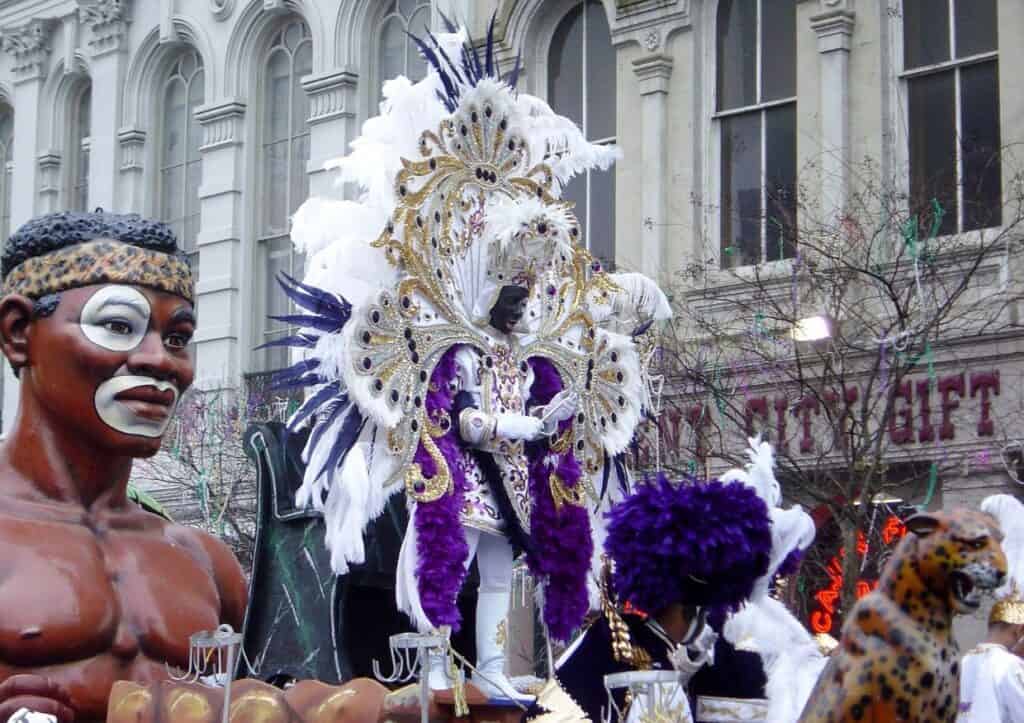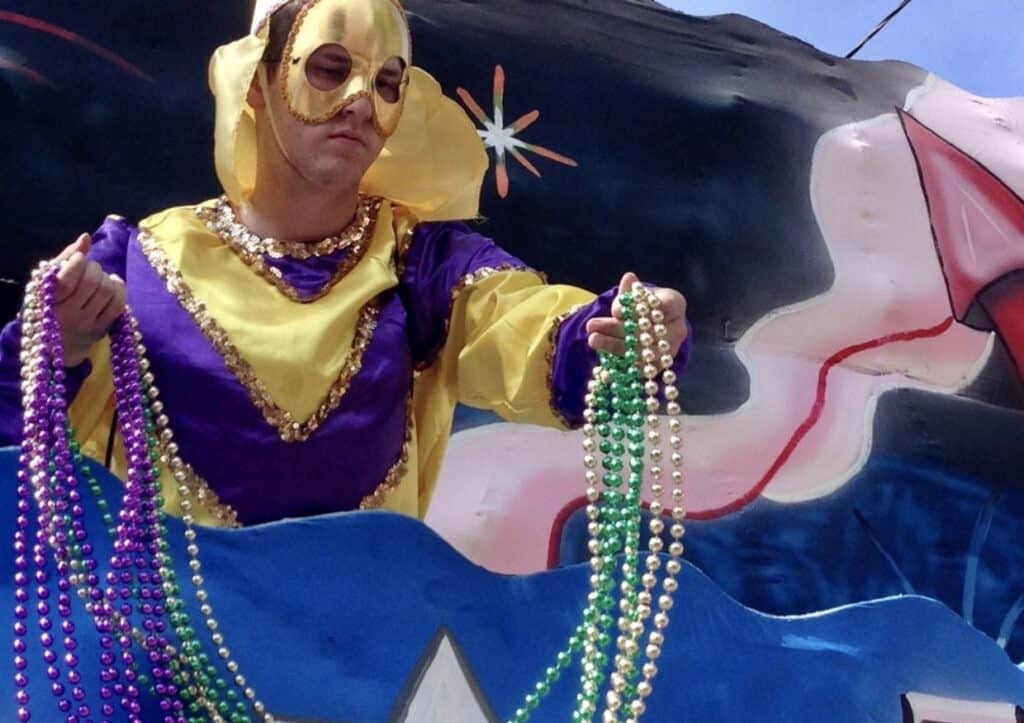Mardi Gras, or Fat Tuesday, captivates with its colorful parades and jubilant festivities. This article explores the fascinating evolution of Mardi Gras traditions, tracing their roots from ancient rituals to today’s exuberant celebrations.

With streets awash in a sea of green, gold and purple, filled with the sounds of jazz and the aroma of mouthwatering cuisine, there’s nothing quite like Mardi Gras. This iconic tradition celebrated in New Orleans and beyond, is a sensory feast steeped in tradition and history.
From masked galas to flamboyant parades, Mardi Gras seamlessly blends ancient customs with modern revelry. Exploring Mardi Gras traditions uncovers the layers of history and cultural significance behind this spectacular celebration.
The origins of Mardi Gras
In Europe during the Middle Ages, Christians would binge-eat meat, cheese, eggs and milk just before the Lenten season. Beginning on Ash Wednesday and lasting through Easter Sunday, Lent is a solemn and spiritually reflective period that often includes ritual fasting.
The evolution of parades
In the mid-1800s, Mardi Gras celebrations in New Orleans were so out of control that local officials threatened to outlaw the pre-Lenten celebrations. But the Mistick Krewe of Comus stepped in and saved Mardi Gras traditions.
This secret society was founded in late 1856, and members committed themselves to creating a more organized method of celebrating Carnival. The first Mardi Gras night parade took place a few months later, featuring a torch-lit procession of elaborate floats, marching bands and revelers in masked costumes.
Rex: The King of Carnival
Rex, the King of Carnival, was introduced in 1872 when a surprise international guest participated in the festivities. When Russian Grand Duke Alexis Romanov toured post-Civil War America, his itinerary placed him in New Orleans at the end of Carnival. And the Big Easy seized this unique opportunity.
Shortly before the duke arrived, New Orleans newspapers announced that a self-proclaimed King of Carnival named Rex — the Latin word for King — would be organizing that year’s festivities. When Fat Tuesday arrived, the parade route was packed with locals who enjoyed a procession of kings, harlequins, peasants and even a costumed version of the Russian duke, the guest of honor.
Today, Rex symbolically rules Mardi Gras. Known as the King of Carnival, Rex is a member of the Rex Organization who is crowned king due to his prominent role in the community and active participation in philanthropic and civic-minded projects.
Flambeaux: Lighting the way in Mardi Gras history
Known as flambeaux, these flaming torches date back to the first Mardi Gras parade organized by the Mistick Krewe of Comus. Originally, the torches were necessary to light the way during the night parade. But with streetlights and other modern conveniences, the flambeaux are simply part of the festivities in 21st-century Mardi Gras celebrations.

The significance of Mardi Gras colors
Mardi Gras colors are purple, gold and green. Once again, this tradition dates back to Russian Grand Duke Alexis’s 1872 visit to Mardi Gras. The three hues are said to be tied to these virtues:
- Purple symbolizes justice.
- Gold represents power.
- Green stands for faith.
As legend has it, the duke came bearing gifts, and his welcoming committee handed out a strand of glass beads to folks demonstrating the color’s significance.
The delight of King Cake
As revelers feast on traditional Mardi Gras foods before fasting and abstaining from sweets during Lent, a king cake is a big part of the festivities. Tasting like a cinnamon roll and looking like a braided coffee cake, king cake is typically decorated with the official colors of Mardi Gras: purple, gold and green.
Hidden inside one bite of king cake is a small baby representing Jesus. It is a symbol of Epiphany, celebrated on January 6th, when the three kings — also known as the three wise men — visited the newborn King of Glory with gifts of frankincense, gold and myrrh.
If you’re the lucky one who discovers the plastic baby in your bite of cake, it is generally expected that you’ll have good luck and increased prosperity in the year ahead. You may also be crowned king for the day, or at least the duration of your Mardi Gras celebration.
“My parents lived in Metairie, Louisiana and brought the king cake tradition with them when they moved to Texas. Every year during Mardi Gras, we’d get a cream cheese king cake from someone who made a run to Haydel’s Bakery. It was a tradition I looked forward to every year and continue with my family.”
— Erin Dooner, Texanerin
The mystery of masks
It is generally believed that Mardi Gras evolved from pagan festivals celebrated throughout the Roman Empire. Feted at the end of December, Saturnalia was an upbeat, party-like celebration where social norms were set aside.
In order to cross-dress with confidence and escape class constraints, Saturnalia involved donning elaborate masks and over-the-top costumes to hide each reveler’s true identity. Think of it as the original Masked Singer, only without singing.
Fun Fact: Believe it or not, wearing masks, hoods and facial disguises is typically outlawed in New Orleans. However, exceptions are made during Mardi Gras. And, if you are riding on a Mardi Gras float, by law, you must wear a mask.

The joy of beads and throws
It’s believed that the original Rex who ruled over Mardi Gras in 1872, when Russian Grand Duke Alexis Romanov was in attendance, tossed beaded necklaces and jewels to his loyal subjects as he glided through New Orleans on his parade float.
By the early 1920s, throws from floats evolved into the Mardi Gras tradition known and loved today. Parade goers will be treated to all sorts of goodies and trinkets, from plastic Mardi Gras necklaces to special Mardi Gras coins known as doubloons that are unique to each Mardi Gras krewe. Some parade attendees may even go home with stuffed animals or a coveted Mardi Gras coconut. The Krewe of Zulu began passing out coconuts in 1910 because they were a less expensive throw than the traditional Mardi Gras beads.
As you interact with float riders during Mardi Gras, please note that you do not need to bare your breasts to get beads. Simply shout, “Throw me something, mister!” and, as they say in New Orleans, “laissez les bons temps rouler,” or let the good times roll.
Mardi Gras: A rich tapestry of tradition
Fat Tuesday is more than just a day of indulgence. It’s a vibrant tapestry woven from centuries of history, rich culture and Mardi Gras traditions. As the joy and camaraderie of this unique festival are embraced, participants become part of a legacy that continues to evolve, celebrating life, community and the enduring spirit of Mardi Gras.
Sage Scott was bitten by the travel bug as a preschooler when her family moved abroad for the first time. Now settled in America’s Heartland, Sage is a travel writer, world wanderer and photographer whose favorite color is golden hour.
This article originally appeared on Everyday Wanderer.